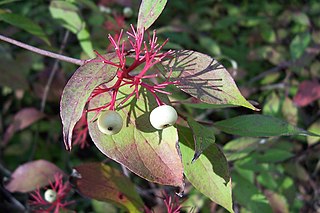
Cornus sericea, syn. C. stolonifera, Swida sericea, red osier or red-osier dogwood, is a species of flowering plant in the family Cornaceae, native throughout northern and western North America from Alaska east to Newfoundland, south to Durango and Nuevo León in the west, and Illinois and Virginia in the east. It has sometimes been considered a synonym of the Asian species Cornus alba. Other names include red willow, redstem dogwood, redtwig dogwood, red-rood, American dogwood, creek dogwood, and western dogwood.

Rosa sericea, the silky rose, is a species of Rosa native to southwestern China, Bhutan, northern India (Sikkim), Nepal and Myanmar; it grows in mountains at altitudes of 2,000-4,400 m.
The elm cultivar Ulmus 'Sericea' was first listed by Lavallée in Arboretum Segrezianum 236, 1877, as Ulmus campestris var. sericea, but without description. Deemed "possibly U. carpinifolia" (:minor) by Green

Leucosidea sericea, commonly known as ouhout in Afrikaans, is an evergreen tree or large shrub that grows in the Afromontane regions of southern Africa. It is the sole species in the genus Leucosidea. The English name "old wood" is simply a direct translation of the Afrikaans words "ouhout" or "oudehout", meaning the same thing.
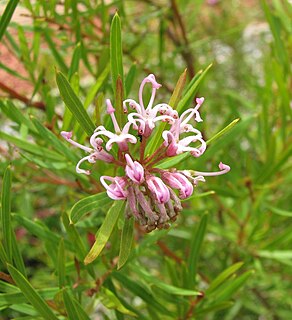
Grevillea sericea, commonly known as the pink spider flower, is a shrub endemic to New South Wales, Australia.
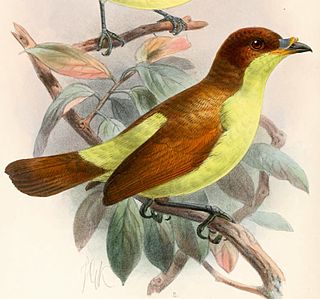
The yellow-breasted satinbird, formerly known as the yellow-breasted bird-of-paradise and also known as the silken satinbird, is a species of bird in the family Cnemophilidae. It is monotypic within the genus Loboparadisea. It is found in the New Guinea highlands. Its natural habitats are subtropical or tropical moist lowland forest and subtropical or tropical moist montane forest. It is threatened by habitat loss.

Pluchea sericea, commonly called arrowweed or Cachanilla (Mexico), is a rhizomatous evergreen shrub of riparian areas in the lower Sonoran Desert and surrounding areas. It is common in the lower Colorado River valley of California, Nevada and Arizona, as far east as Texas, and in northern Mexico where it often forms dense impenetrable thickets.

Hakea sericea, commonly known as needlebush or silky hakea, is a large species of shrub native to Australia. It is native to New South Wales, Victoria and Tasmania but is found outside these states.

Hibbertia sericea, or silky Guinea-flower, is a species of small perennial shrub, in the family Dilleniaceae, that is endemic to Australia. It has small yellow five-petalled flowers 2 centimetres (0.8 in) to 3 centimetres (1.2 in) across.

Phacelia sericea, the silky phacelia or blue alpine phacelia, is a showy perennial species of Phacelia endemic to western North America. Uncommon, it grows mainly at subalpine to alpine elevations in forest openings or above treeline among rocks and sand. Sericea comes from the Latin sericeus, or silky, referring to the fine hairs on the leaves and stem.

Adenanthos macropodianus, commonly known as gland flower, or Kangaroo Island gland flower, is a species of shrub in the family Proteaceae. It is endemic to Kangaroo Island in South Australia. First published as a variety of A. sericeus in 1870, it was promoted to species rank in 1978.

Lespedeza cuneata is a species of flowering plant in the legume family known by the common names Chinese bushclover and sericea lespedeza, or just sericea. It is native to Asia and eastern Australia and it is present elsewhere as an introduced species and sometimes an invasive plant.
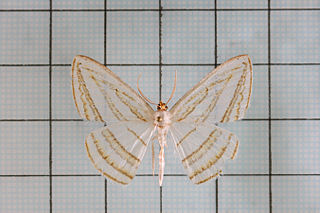
Orthocabera sericea is a species of moth of the family Geometridae first described by Arthur Gardiner Butler in 1879. It is found from the Himalayas to Taiwan and Japan.

Stemorrhages sericea, the large emerald pearl, is a moth of the subfamily of Spilomelinae within the Crambidae family. It lives throughout Africa south of the Sahara, and the Indian Ocean islands of Réunion, Madagascar, Mauritius and the Comoros.
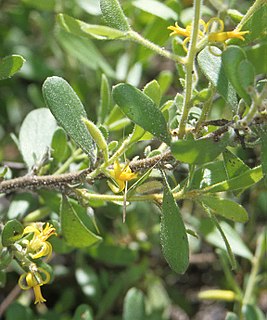
Persoonia sericea, commonly known as the silky geebung, is a plant in the family Proteaceae and is endemic to eastern Australia. It is a shrub with hairy yellow flowers and silky-hairy young branches and leaves.

Neolitsea sericea is a species of tree in the Lauraceae family. It is found in China, Taiwan, south Korea, and Japan. Its natural habitat is on forest margins and slopes, and it is often found in well-progressed secondary forests.

Daphne sericea is a shrubby species of flowering plant in the genus Daphne with purple flowers. It was described by Martin Vahl. Daphne collina has been treated as a separate species, but is considered to be a cultivar or group of cultivars of D. sericea.

Mesosini is a tribe of longhorn beetles of the Lamiinae subfamily.

Polybia sericea is a social, tropical wasp of the family Vespidae that can be found in South America. It founds its colonies by swarming migrations, and feeds on nectar as well as other arthropods.

Patersonia sericea, commonly known as the purple flag, native iris, silky purple flag or native flag is a species of plant in the iris family Iridaceae which is endemic to eastern Australia. It is relatively easy to cultivate, and even the type specimen provided to the taxonomist, Robert Brown was "...furnished us by Messrs. Lee and Kennedy, of Hammersmith, [West London] who received the seeds, from which they raised it, from Port Jackson".





















